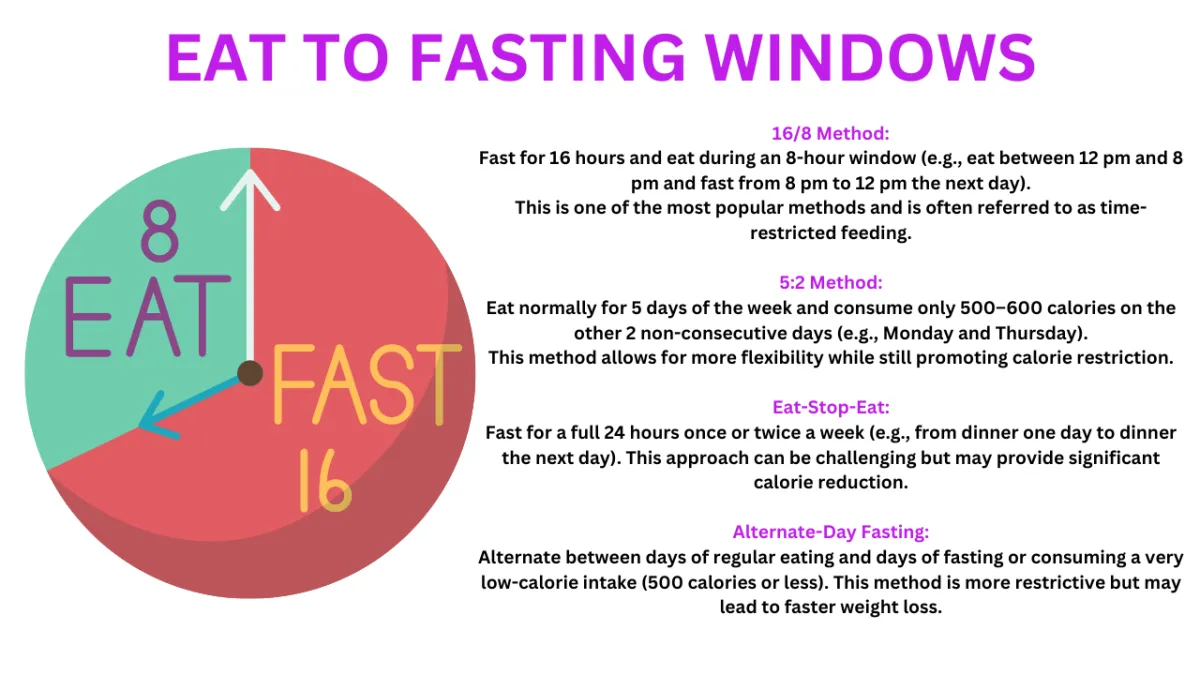INTERMITTENT FASTING
Intermittent Fasting (IF)
Is an eating pattern that alternates between periods of eating and fasting. It focuses more on when you eat rather than what you eat. The primary goal of intermittent fasting is to help with weight management, improve metabolic health, and simplify meal planning.an eat any food that fits into your daily macro targets.

Why People Like Intermittent Fasting for Weight Loss
Simplicity and Flexibility: No Calorie Counting: Unlike many diets, intermittent fasting does not require meticulous calorie counting or tracking of specific foods. It is a simpler approach focused on timing rather than restricting specific foods.
Flexible Eating Patterns: People can choose the fasting method that best fits their lifestyle, work schedule, and social commitments, making it easier to maintain over the long term.
Encourages Fat Burning: Improved Fat Burning: During fasting, insulin levels drop, and the body shifts from burning glucose for energy to burning stored fat. This process, known as ketosis, can enhance fat loss.
Preserves Muscle Mass: Some research suggests that intermittent fasting may help preserve lean muscle mass better than continuous calorie restriction because of its potential to optimize hormones like growth hormone and norepinephrine.
Health Benefits Beyond Weight Loss: Improved Metabolic Health: Intermittent fasting may improve markers like blood sugar control, insulin sensitivity, cholesterol levels, and blood pressure, reducing the risk of type 2 diabetes and heart disease.
Reduced Inflammation: Studies suggest intermittent fasting may reduce inflammation and oxidative stress, potentially lowering the risk of chronic diseases.
Autophagy Promotion: Fasting can trigger a cellular repair process called autophagy, where cells remove damaged components, potentially reducing the risk of aging-related diseases.
Simplifies Daily Routine: Fewer Meals to Prepare: By reducing the eating window, there are fewer meals to plan and prepare, which can save time and simplify the daily routine.
No Need for Special Foods: There are no special foods or supplements required, making it cost-effective and easy to adopt.
Supports Mindful Eating: Improved Relationship with Food: By controlling when to eat, people often become more mindful about their hunger cues, eating habits, and portion sizes, which can lead to healthier eating patterns.
Prevents Overeating: The fasting period naturally limits eating opportunities, which can help reduce mindless snacking and overeating.
Suitable for Various Lifestyles: Compatible with Different Diets: Intermittent fasting can be combined with various dietary preferences, such as low-carb, vegan, or paleo, providing flexibility to adapt to individual needs and tastes.
Convenient for Busy Schedules: The lack of strict meal planning makes it easier for people with busy lifestyles to adhere to the diet without constant planning or preparation.
Overall, Intermittent Fastingis popular for its flexible approach, potential health benefits, and simplicity. It can be an effective tool for weight loss and improving metabolic health while allowing people to enjoy a range of foods without strict limitations.

Here's a sample day following the 16/8 method of intermittent fasting, which involves fasting for 16 hours and eating within an 8-hour window. In this example, the eating window is from 12 PM to 8 PM:
Fasting Period (8 PM - 12 PM)
8:00 AM: Start the day with a glass of water. You can also have herbal tea or black coffee if desired.10:00 AM: Drink another glass of water or herbal tea. Keep hydrated throughout the fasting period.
Eating Window (12 PM - 8 PM)
12:00 PM - Lunch
Grilled Chicken Salad:4 oz grilled chicken breast Mixed greens (spinach, arugula, romaine) Cherry tomatoes, cucumber, bell peppers¼ avocado Olive oil and balsamic vinegar dressing
3:00 PM - Snack
Greek Yogurt with Berries:1 cup plain Greek yogurt½ cup mixed berries (blueberries, strawberries)1 tablespoon chia seeds
5:00 PM - Dinner
Salmon with Roasted Vegetables:6 oz baked salmon fillet Roasted vegetables (broccoli, carrots, bell peppers, seasoned with olive oil and herbs)½ cup quinoa or brown rice
7:30 PM - Pre-Fast Snack (Optional)
Apple Slices with Almond Butter:1 medium apple, sliced1 tablespoon almond butter
Fasting Period Resumes (8 PM - 12 PM)
8:00 PM: Begin fasting again. Continue drinking water or herbal tea if desired.
This sample day provides a structured approach to intermittent fasting, focusing on nutrient-dense foods and balanced meals to help you maintain energy levels and support weight loss goals.
Here are some tips to help you succeed with intermittent fasting:
1. Stay Hydrated
Drink plenty of water throughout the fasting period to stay hydrated and help manage hunger. Herbal teas and black coffee are also acceptable.
2. Plan Your Meals
Plan and prepare your meals and snacks in advance to ensure you have healthy options ready and avoid the temptation to make poor food choices.
3. Eat Balanced Meals
Ensure your meals during the eating window are balanced with a good mix of protein, healthy fats, and fiber. This helps keep you full longer and provides essential nutrients.
4. Listen to Your Body
Pay attention to hunger and fullness cues. It’s important to eat enough during your
eating windows to meet your nutritional needs without overeating.
5. Avoid Overeating
It can be tempting to overeat when you’re in your eating window. Focus on portion control and avoid high-calorie, low-nutrient foods.
6. Be Consistent
Consistency is key for intermittent fasting. Stick to your fasting and eating windows as closely as possible to maintain your body’s internal clock and metabolism.
7. Incorporate Nutrient-Dense Foods
Focus on whole, nutrient-dense foods like fruits, vegetables, lean proteins, whole grains, nuts, and seeds to ensure you’re getting a wide range of vitamins and minerals.
8. Adjust Gradually
If you’re new to intermittent fasting, start gradually. You might begin with a shorter fasting period and increase it as your body adjusts.
9. Manage Hunger
If you feel excessively hungry during fasting periods, drink water or herbal tea to help manage cravings. Sometimes, thirst can be mistaken for hunger.
10. Maintain Physical Activity
Incorporate regular exercise into your routine. Exercise can help with weight loss, improve overall health, and complement the effects of intermittent fasting.
11. Sleep Well
Ensure you’re getting adequate sleep. Poor sleep can affect hunger hormones and make it harder to stick to your fasting plan.
12. Track Your Progress
Keep a journal or use an app to track your eating patterns, hunger levels, and any changes in your weight or health. This can help you make necessary adjustments.
13. Be Flexible
Life can be unpredictable. If you occasionally miss a fasting period or eating window, don’t stress. Get back on track with your next meal or fasting period.
14. Consult a Professional
If you have any underlying health conditions or concerns, consult with a healthcare provider or dietitian before starting intermittent fasting to ensure it’s appropriate for you.
15. Stay Educated
Educate yourself about intermittent fasting and its effects on your body. Understanding the science and benefits can help you stay motivated and make informed choices.
By following these tips, you can enhance your chances of success with intermittent fasting and achieve your health and weight loss goals more effectively.